| Time | # | Screenshot | Description |
| 00.00 | 1 | [not available] |
INT. PROJECTION ROOM Projectionist (Keaton) looks at projector, screen L. Backs away. DISSOLVE TO: |
| 00.03 | 2 | [not available] |
INT. MOVIE THEATRE Seated audience in lower third. Movie screen straight ahead. Inner screen 2a INSERT FILM TITLES: ‘Hearts and Pearls’. DISSOLVE TO: 2b EXT. LARGE, GRAND TIMBERED HOUSE DISSOLVE TO: |
| 00.13 | 3 |
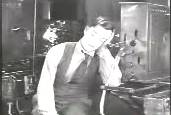
|
INT. PROJECTION ROOM Slightly high angle MS K facing screen R. Turns towards us. Sits. Takes notebook (?) from back R pocket and glances at it. Stifles yawn. Rests head on L hand and dozes off. CUT TO: |
| 00.27 | 4 |
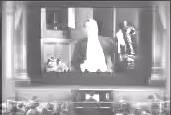
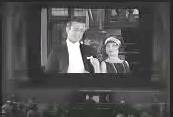
|
INT. MOVIE THEATRE Tighter shot than 2 of movie screen and orchestra. Inner screen 4a INT. STUDY. MS of man in evening dress facing us. Smiles and puts pearls in a case and then in open safe screen L. Closes safe. Moves off screen R. DISSOLVE TO: 4b INT. HALLWAY MCU couple - different man in evening dress,
screen L, woman in pearls screen R standing beside him and tweaking the
handkerchief in his top pocket. |
| 00.38 | 5 |
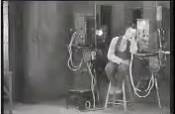 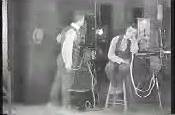
|
INT. PROJECTION ROOM LS of K asleep screen R.
Optical effect used to show translucent dream-figure
of K (d-K) step out of his own sleeping body (s-K). d-K looks back into
theatre at back of screen. |
| 00.51 | 6 |
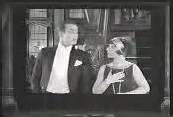
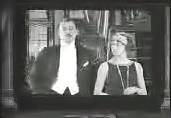
|
INT. MOVIE THEATRE Tighter shot of screen excluding orchestra. Inner screen 6a INT. HALLWAY Tight frontal MS of same man and woman side-by-side as before. She turns away from his and us. Man too then turns away. An optical effect is just visible. She turns back and so does he. They have been transformed into K’s rival and his girl. CUT TO: |
| 01.14 | 7 |
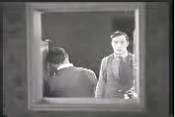
|
INT. PROJECTION ROOM Within framing of projectionist room window onto theatre, frontal MS of d-K on R looking towards us; we also see back of s-K. d-K looks screen L and tries to wake s-K with his arm, pointing towards us in the movie theatre. CUT TO: |
| 01.20 | 8 |
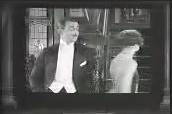
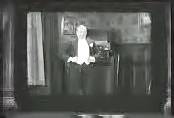
|
INT. MOVIE THEATRE Inner screen 8a INT. HALLWAY Tight frontal MS of K’s rival (as the villain) and his girl. Girl turns away and mounts stairs screen R. Man looks at retreating figure, glances towards us and then down and to screen L, then once again looks up the stairs, then mounting them. CUT TO: 8b INT. DRESSING ROOM Frontal LS of a man facing us, then turning with his back to us towards a chest of drawers. In an optical effecr, the man dissolves into a much younger man. He dons a top hat, grabs a cane and faces front, before walking off theatrically towards us. CUT TO: |
| 01.45 | 9 |
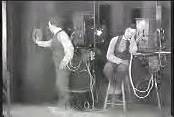
|
INT. PROJECTION ROOM LS of d-K (facing R) at screen L and s-K at R (facing us). d-K turns towards us, then towards screen L, grabs his hat from hook on L, puts it on his head and walks off screen L (original hat is still there!). CUT TO: |
| 01.54 | 10 |
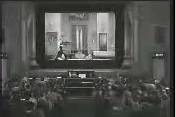
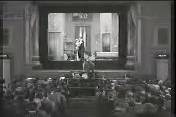
|
INT. MOVIE THEATRE Returns to original framing with view of audience. Inner screen 10a INT. GRAND ROOM Woman in LS enters screen L. In a strange optical effect, she dissolves into the man whilst she reappears (dissolve) in the centre of the room. Just at this moment we see d-K’s back appear in the movie theatre aisle (centre foreground) as he faces the movie screen. The screen man locks the door and pockets the key. d-K moves towards the screen, sitting on the R of the aisle near the orchestra pit. The screen man pulls the woman roughly towards him in an embrace. d-K clambers onto the stage screen R, confronting the man and holding his arm. The villain throws d-K out of the room and he rolls back onto the theatre stage. The man turns back to the woman as d-K rolls into the orchestra pit. DISSOLVE TO: |
| 02.20 | 11 |
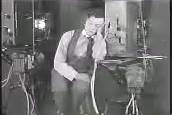
|
INT. PROJECTION ROOM MLS of s-K facing us and jumping in his sleep. DISSOLVE TO: |
| 02.22 | 12 |
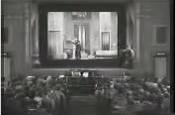
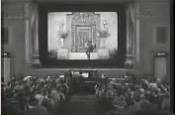
|
INT. MOVIE THEATRE Same framing as 10. d-K stands up, walks to screen R, climbing stage again. d-K turns imploringly to the movie theatre audience. Inner screen: 12a INT. GRAND ROOM. Man and woman as before. CUT TO: 12b EXT. GRAND DOORWAY Not having noticed the screen change, d-K, staggering into inner screen, looks puzzled and turns to face us, scratching his head. As he does so the door behind him opens and the top-hatted man appears. d-K turns round towards him. The grand door closes as the man stands at the top of the steps. CUT TO: |
| 02.45 | 13 |
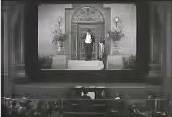
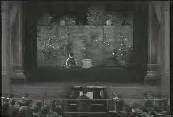
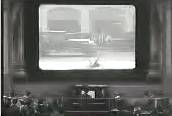
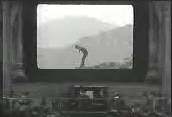
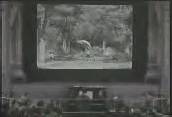
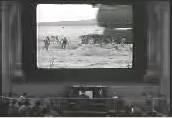
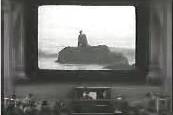
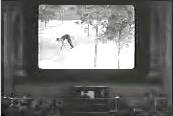
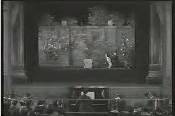
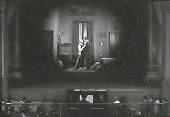
|
INT. MOVIE THEATRE Tighter shot of inner screen and orchestra pit only. Inner screen: 13a EXT. GRAND DOORWAY The top-hatted man seems to have forgotten something and he returns inside, closing the door after him. d-K knocks but there is no answer. d-K turns back to us. d-K is about to descend the steps... CUT TO: 13b EXT. GRAND GARDEN d-K (foreground), now standing on a stone garden seat, falls off it, looks around, puts his hat on his head and, facing us, he goes to sit down on the seat. DISSOLVE TO: 13c EXT. STREET Cars are parked on the far side of the road (behind d-K). The seat has disappeared and d-K (foreground) falls over again as a car enters from L. He stands up and jumps out of the way as another vehicle enters from L behind him. He strides off purposefully L along the pavement. As he reaches mid-screen... DISSOLVE TO: 13d EXT. MOUNTAIN XLS. d-K (foreground) has to stop himself from plunging forward off the edge of the mountain and he turns screen R, clutching at the rocks and scrambling back up. He looks around, peers over the edge and... DISSOLVE TO: 13e EXT. JUNGLE Seated lions on R and L of screen. K retreats further into the jungle. CUT TO: 13f EXT. DESERT d-K emerges from a hollow, falling over the lip and clambering up a dune. He looks round and is narrowly missed by a speeding train travelling from R to L. d-K kicks at the sand, climbs the dune again, looks round and sits down. DISSOLVE TO: 13g EXT. SEA d-K is sitting on a rock in the sea, and a wave breaks over him from behind. He looks around again, stands up and clambers around. He goes to leap in the sea screen L. DISSOLVE TO: 13h EXT. SNOWY WOODLAND XLS. d-K leaps into a snowy hollow screen L, his legs left waving in the air. He stands up and looks around again, and then faces us, hands on hips. He goes to lean on a tree mid-screen. DISSOLVE TO: 13i EXT. GRAND GARDEN d-K (foreground) falls over the stone seat. FADE TO BLACK FADE IN (theatrical spot effect): 13j INT. GRAND ROOM LS of villain and woman together again (no sign of d-K). TRACK IN on inner screen, until it nearly fills the full frame |
| 05.04 | [End of clip] |
Note that the formal structural relationship of these shots (montage) can be neatly represented using the conventions employed in mapping the rhyme scheme of a poem. Thus, within the 'outer' framing shot if we label the Projection Room A and the Movie Theatre B, we may record the sequence of these shots as 'ABAB...' (etc.), noting that the last shot is a reframing of the previous location and thus the final sequence is 'BB'. Since we also have 'inner' shots we may use small letters to represent the relationship between these. Based on shot locations, the sequence would thus be:
- A
- B (ab)
- A
- B (cd)
- A
- B (d)
- A
- B (de)
- A
- B
- A
- B (fg)
- B (ghijklmnhf)
ABAB ('alternating montage' - or 'parallel syntagms' to semioticians) is, of course, a very conventional narrative structure. It is also the structure of 'shot-reverse shot' sequences. ABAB could quickly becoming very boring. However, this mapping highlights how the inner form in this clip becomes increasingly irregular (although the repetition of f provides structural closure). Using the rhyme scheme formula, David Bordwell alludes to the importance of repetition and difference in relation to the manipulation of the film viewer's expectations (Bordwell & Thompson 1993, 45ff).
Note that in the initial shot within the movie theatre (shot 2) where the inner screen is totally blank, I have not recorded this as an inner shot but simply as part of the main shot.
Maybe the patterns appear clearer if we schematise the structure thus:
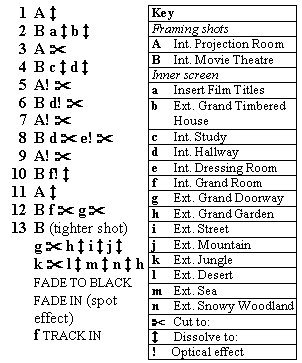
At first glance, the choice of transitions (primarily cuts and dissolves) seems to be fairly unsystematic, but is it?
As for shot sizes, the sequence for the projection room ('A') is as follows: (1)MS, (3)MS, (5)LS, (7)MS, (9)LS, (11)MLS. In the movie theatre ('B'), note the use of three distances. Although the labels long-shot, mid-shot and close-up are seldom applied to inanimate objects we may use these terms as a shorthand thus...
The progression for these shots is thus: (2)LS, (4)MS, (6)CU, (8)CU, (10)LS, (12)LS,
(13)MS to CU (at end).
NB: These notes seek to offer a descriptive shot-by-shot breakdown and do not
constitute an 'analysis'. There are many paths which one could pursue to go
deeper into this clip.
For instance, it clearly plays with the notion of what is 'real'. One interesting
strategy would be to look at the different 'levels' of reality which
the projectionist is depicted as experiencing. How is this reflected in the
structural devices already outlined?
Here is an extract from Robert Stam's commentary...
In Sherlock Jr. (1924), Buster Keaton plays a neighbourhood projectionist who
aspires to be a detective. As he falls asleep in the projection booth, his dream-double
fantasizes the characters of the film he is projecting - 'Hearts and Pearls' - into his
real-life girlfriend and playboy enemy. Imagining the heroine's honour threatened, the
somnambulent Buster rushes down the aisle, scrambles over the orchestra pit and, after
several failed attempts, manages to penetrate the screen world, where he is transformed
into the redoubtable son of Sherlock Holmes.
Although framed as a comedy, Sherlock Jr. constitutes a profound meditation
on the film/dream analogy. It offers a fictive demonstration, first of all, that films,
like dreams according to the Freudian hypothesis, are designed to fulfil wishes. On the
most superficial level, Buster's film-dream satisfies his desire for the girl...
With intuitive brilliance, Keaton makes his hero a projectionist, who not only projects
films but also projects himself into films. The familiar erotic motivations prompt
his entrance into the screen world; like Don Quixote, he fantasizes rescuing damsels in
distress. He clambers over the piano and leaps into the screen, but the villain throws
him out into the orchestra pit. Then he creeps up from the side, as if in hopes of a discreet
lateral infiltration. Buster's clumsy but finally successful attempts at penetration
comically literalize, I think, the process whereby spectators identify with the diegesis
and characters of a classic fiction film...
Once inside the screen world, Buster discovers the treacherous nature of what Suzanne
Langer calls film's 'inconstant space'.
The film's unpredictable cutting sends him tumbling over a park bench, sits him in the
middle of city traffic, and places him on the edge of a rocky precipice. Betrayed by a
splice, he dives from a reef in mid-ocean and lands headfirst in a snowbank. Metx points
out in 'The Imaginary Signifier' that before we can identify with characters we must
first identify with the camera's act of seeing. This 'primary identification' makes
possible 'secondary identification' with characters... Primary identification in the
cinema usually operates surreptitiously. The camera... takes us everywhere... The
spectator becomes the all-perceiving subject... Sherlock Jr. turns the tables on
this spectatorial self by putting Buster, our delegate in the fiction, literally in the
places where the camera went. Buster physically accompanies the camera into deserts
and icy wastes, rather than mentally identifying with it from a sheltered place in a
movie theatre. Keaton collapses the transcendental and empirical subject. Whereas the
transcendental subject customarily follows the camera within the sanctuary of his or
her mind, here the character is made empirically subject to the space of the image and
the time of the editing...
(Stam 1992, 37-9)
References
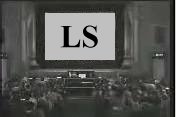
Framing used for shots 2, 10 and 12
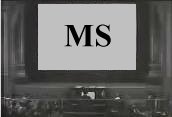
Framing used for shots 4 and 13
(until the final track in)

Framing used for shots 6, 8 and 13
(after track in)

home ::
admin ::
lectures ::
reading ::
assignments ::
modules ::
tutor